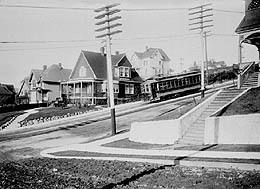This entry contains Seattle historian and photographer Paul Dorpat's photograph and reflections on the counterbalance system of getting trolley cars up the steep grade of Queen Anne Hill around 1905.
The Counterbalance
Of the many depictions of Queen Anne's long defunct but not forgotten counterbalance, this is one of the best. The photograph was taken about 1905 when Queen Anne Hill was just beginning to refoliate its stripped condition.
Looking west from Prospect Street across Queen Anne Avenue, car No. 312 is caught descending Queen Anne Avenue's steepest grade – about 20 percent – between Highland Drive and Prospect. What's not evident is the counterbalance itself: the narrow-gauged railroad car loaded with 16 tons of concrete which is going up the hill as car No. 312 goes down it. The two cars are, of course, traveling at exactly the same speed, about 8 miles per hour, for they are attached by a cable which like the concrete counterweight is hidden underground.
Cars first climbed this way to Queen Anne's summit in 1890. They were, however, not electric trolleys aided here by a system of counterbalances– up for power, down for brakes – but by a simple cable. In 1901, the cable was removed and the counterbalance introduced for the new electric trolleys. And in 1902 the Seattle Electric Company added 10 new cars to this service, No. 312 among them. All of them survived until 1940 when the system was discarded for a combination of trackless trolleys and gas-powered buses.
Like the others, No. 312 was soon scrapped. The tracks and tunnels beneath them, however, were at first left alone on the chance that the old system might be needed in a blizzard. But in 1943, the tracks too were removed and so also the cable slots between them. When the trackless trolleys were also cut out in the 1970s, diehard trolley buffs were satisfied to learn that the diesel buses left to climb the counterbalance were sometime strained to the point of collapse. But now, many decades since the trolleys were last helped up Queen Anne Hill, it is a rueful thought that soon there will be no one left to both remember them and expect their return.

